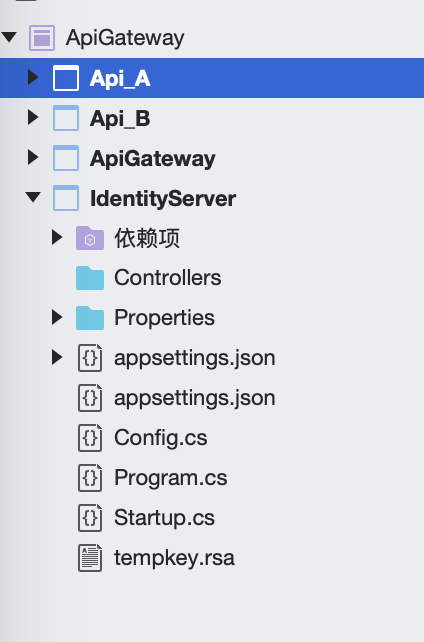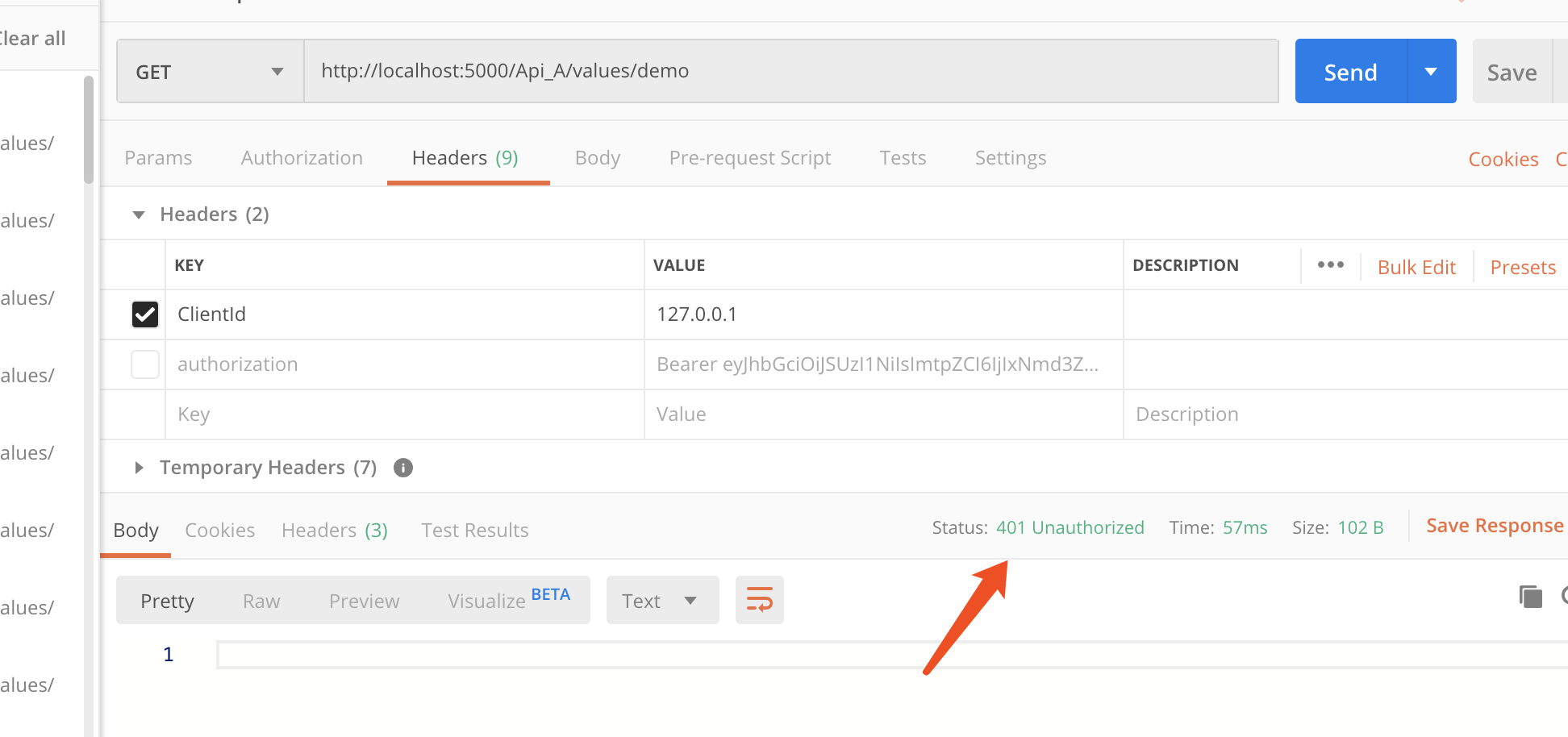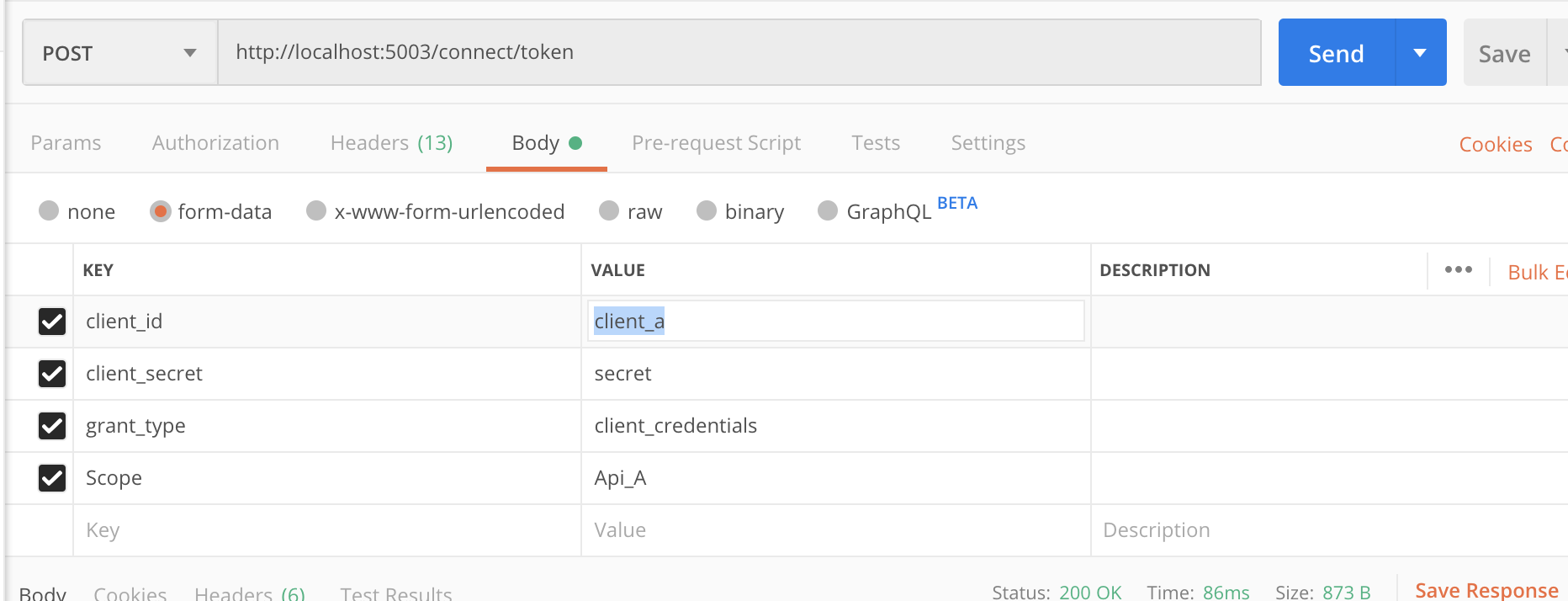.Net Core使用Ocelot閘道器(二) -鑑權認證
前言
上一章已經簡單的介紹了ocelot的使用了,但是閘道器暴露的介面如果什麼人都能訪問的話安全性就太低啦。所以我們需要去鑑權和認證。這裡我們使用identityServer4給我們的閘道器來鑑權認證。
建立Identity服務
我們建立一個identity的服務來用於令牌的發放和鑑權。下圖是我的專案結構。

Api_Gatewat埠:5000
Api_A埠:5001
Api_B埠:5002
IdentityServer埠:5003
通過nuget新增IdentityServer4的包,也可以通過程式包管理控制檯執行以下命令Install-Package IdentityServer4。
新增一個Congif檔案。
using System.Collections.Generic; using IdentityModel; using IdentityServer4; using IdentityServer4.Models; namespace IdentityServer { public static class Config { public static IEnumerable<IdentityResource> GetIdentityResourceResources() { return new List<IdentityResource> { new IdentityResources.OpenId(), //必須要新增,否則報無效的scope錯誤 }; } // scopes define the API resources in your system public static IEnumerable<ApiResource> GetApiResources() { //可訪問的API資源(資源名,資源描述) return new List<ApiResource> { new ApiResource("Api_A", "Api_A"), new ApiResource("Api_B", "Api_B") }; } public static IEnumerable<Client> GetClients() { return new List<Client> { new Client { ClientId = "client_a", //訪問客戶端Id,必須唯一 //使用客戶端授權模式,客戶端只需要clientid和secrets就可以訪問對應的api資源。 AllowedGrantTypes = GrantTypes.ClientCredentials, ClientSecrets = { new Secret("secret".Sha256()) }, AllowedScopes = { "Api_A",IdentityServerConstants.StandardScopes.OpenId,IdentityServerConstants.StandardScopes.Profile } }, new Client { ClientId = "client_b", ClientSecrets = new [] { new Secret("secret".Sha256()) }, AllowedGrantTypes = GrantTypes.ClientCredentials, AllowedScopes = { "Api_B",IdentityServerConstants.StandardScopes.OpenId,IdentityServerConstants.StandardScopes.Profile } } }; } } }
新增兩個API資源,並且新增兩個客戶端分別去訪問不同資源。
在 Startup 中的 ConfigureServices 中配置IdentityServer服務。
public void ConfigureServices(IServiceCollection services) { services.AddIdentityServer() .AddDeveloperSigningCredential() .AddInMemoryApiResources(Config.GetApiResources()) .AddInMemoryClients(Config.GetClients()); }
在 Configure 中把IdentityServer放入http管道中。
public void Configure(IApplicationBuilder app, IWebHostEnvironment env)
{
if (env.IsDevelopment())
{
app.UseDeveloperExceptionPage();
}
app.UseIdentityServer();
}為ocelot整合Identity
通過nuget新增IdentityServer4.AccessTokenValidation的包,也可以通過程式包管理控制檯執行以下命令 Install-Package IdentityServer4.AccessTokenValidation
IdentityServer4.AccessTokenValidation - 用於驗證IdentityServer4中的JWT和引用令牌
在 Startup 的 ConfigureServices 中分別註冊兩個認證方案 Configure 中配置IdentityServer服務。
public void ConfigureServices(IServiceCollection services)
{
services.AddAuthentication()
.AddJwtBearer("Api_A", i =>
{
i.Audience = "Api_A";
i.Authority = "http://localhost:5003";
i.RequireHttpsMetadata = false;
}).AddJwtBearer("Api_B", y =>
{
y.Audience = "Api_B";
y.Authority = "http://localhost:5003";
y.RequireHttpsMetadata = false;
});
services.AddOcelot(new ConfigurationBuilder()
.AddJsonFile("configuration.json")
.Build());
}
public void Configure(IApplicationBuilder app, IWebHostEnvironment env)
{
if (env.IsDevelopment())
{
app.UseDeveloperExceptionPage();
}
app.UseOcelot();
app.UseAuthorization();
}並修改ocelot配置檔案,在Routes中新增授權資訊
{
"ReRoutes": [
{
"UpstreamPathTemplate": "/Api_A/{controller}/{action}",
"DownstreamPathTemplate": "/api/{controller}/{action}",
"UpstreamHttpMethod": [ "GET", "POST", "DELETE", "PUT" ],
"DownstreamScheme": "http",
"DownstreamHostAndPorts": [
{
"Host": "localhost",
"Port": 5001
}
],
"RateLimitOptions": {
"ClientWhitelist": [ "127.0.0.1" ],
"EnableRateLimiting": true,
"Period": "1m",
"PeriodTimespan": 30,
"Limit": 5
},
"FileCacheOptions": {
"TtlSeconds": 5,
"Region": "time"
},
"UpstreamHeaderTransform": {
"demo": "a,b"
},
"DownstreamHeaderTransform": {
"demo": "xxxxxxx",
"Location": "{DownstreamBaseUrl},{BaseUrl}"
},
//授權資訊
"AuthenticationOptions": {
"AuthenticationProviderKey": "Api_A",
"AllowedScopes": []
}
},
{
"UpstreamPathTemplate": "/Api_B/{controller}/{action}",
"DownstreamPathTemplate": "/api/{controller}/{action}",
"UpstreamHttpMethod": [ "GET", "POST", "DELETE", "PUT" ],
"DownstreamScheme": "http",
"DownstreamHostAndPorts": [
{
"Host": "localhost",
"Port": 5002
}
],
//授權資訊
"AuthenticationOptions": {
"AuthenticationProviderKey": "Api_B",
"AllowedScopes": []
}
}
],
"QoSOptions": {
"ExceptionsAllowedBeforeBreaking": 3,
"DurationOfBreak": 20,
"TimeoutValue": 5000
},
"GlobalConfiguration": {
"RateLimitOptions": {
"DisableRateLimitHeaders": false,
"QuotaExceededMessage": "介面限流!",
"HttpStatusCode": 200,
"ClientIdHeader": "ClientId"
}
}
}Ocelot會去檢查ReRoutes是否配置了AuthenticationOptions節點。如果有會根據配置的認證方案進行身份認證。如果沒有則不進行身份認證。
AuthenticationProviderKey 是剛才註冊的認證方案。
AllowedScopes 是 AllowedScopes中配置的授權訪問範圍。
演示效果
我們為api_a和api_b分別註冊了認證方案。如果我們不申請token是會401沒有許可權訪問。

我們通過identityServer申請一個的token,並用它訪問api_a和api_b。



可以看到我們申請的token是可以訪問api_a的,但是不能訪問api_b,因為client_a這個客戶端只有訪問api_a的權利。如果想訪問api_b使用client_b申請token就可以啦。
總結
簡單為Ocelot集成了IdentityServer,希望對大家有參考價值。如果文中有錯誤請聯絡我更改
